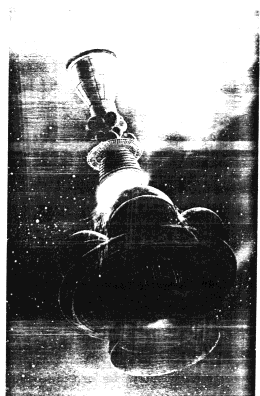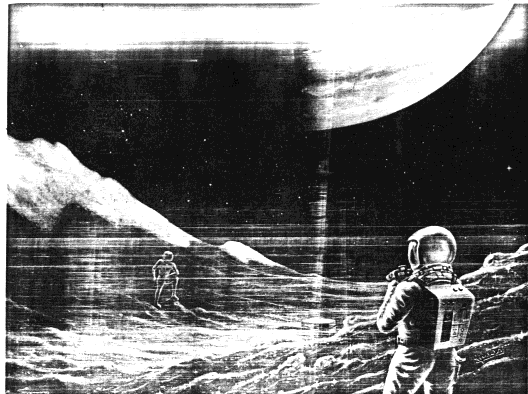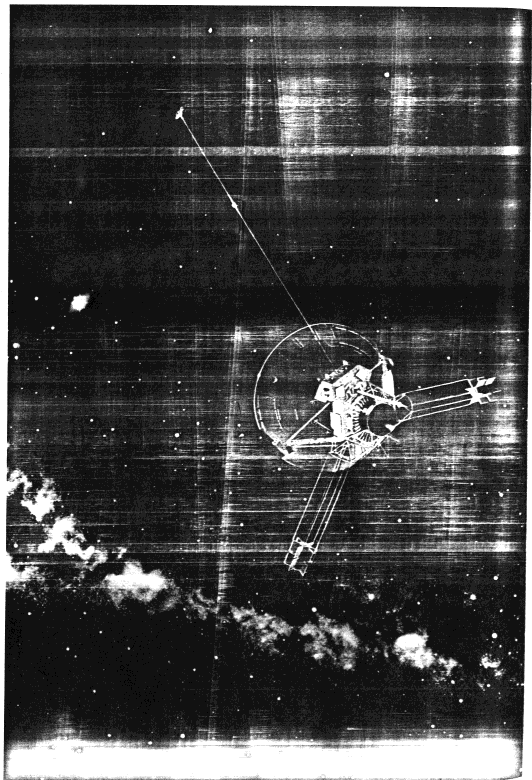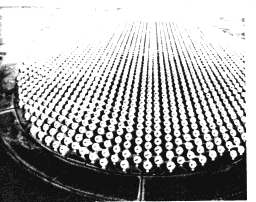
The BIS Daedalus probe is an early attempt at
spreading Man's presence throught the Galaxy.
(Painting by Don Dixon, donated by Space Frontiers Ltd)
Spaceflight 26(December 1984):438-441.
Note: This web version is derived from an earlier draft of the paper and may possibly differ in some substantial aspects from the final published paper.
The Fermi Paradox, attributed to a famous question from physicist Enrico Fermi in 1943, asks: if there are intelligent beings elsewhere then, in time, they must achieve the technology of nuclear power and space flight and would explore and colonize the Galaxy. Thus, they should have been able to travel to Earth, but we see no evidence of such visitations. Ergo, they cannot exist. The author, of the Xenology Research Institute in California, discusses this viewpoint and suggests how and where we might be able to detect an alien presence in the Solar System.
The idea that aliens might have sent an interstellar probe here to reconnoitre our star system and its environs is not implausible. We sent Viking to Mars to search for life. The alien device would be something like our own interstellar probes, the four Pioneer and Voyager spacecraft, but more sophisticated.
A typical alien probe might be 1 to 10 m in size, large enough to house a microwave antenna to report back and to- survive micrometeorite impacts for millions of years, yet fight enough to fly across the interstellar abyss without consuming too much energy. Where might it be? Finding it is rather like searching a beach for one special, oddly-shaped grain of sand.
The ability of a telescope to detect faint objects is measured by its visual magnitude limit. The unaided eye can see down to sixth magnitude. The sky is exhaustively and repeatedly surveyed by amateurs to, at best, magnitude +14. The Palomar Schmidt Sky Survey extends to +21, but these plates are just 'snapshots' of small areas and cannot be counted as a search. The best telescope on Earth reaches only to +24.
These three magnitude limits correspond roughly to an unmoving, mirror-shiny, optimally-oriented 10 m object orbiting at 0.01, 0.25 and 1 AU from Earth, respectively. A smaller, moving, dark or angled object would be even harder to see. So we can scan at best only the nearest cubic AU of space for probes, but there is 260,000 cubic AU to search. Even if Mount Palomar was employed exclusively to look for alien artifacts it could scan only one-millionth of the necessary volume. Orbital space, in other words, is at least 99.9999% unexplored for 1 to 10 m objects.
Now consider probes on planetary surfaces. Of the 1011 km2 of Solar System territory outside of Earth, less than 50 million has been examined down to 1 to 10 m resolution. So 99.95% is still virgin territory for this purpose. If objects are buried somewhere or floating in the Jovian atmosphere, there is no chance yet that they could have been found. Even huge 1 to 10 km artificial alien habitats in the Asteroid Belt would be visually indistinguishable from asteroids to terrestrial observers, and the Belt population itself is poorly catalogued.
So it is very unlikely that an extraterrestrial artifact in the Solar System would be seen unless it was deliberately signalling its presence.
Detecting an operating self-replicating machine system is only marginally easier to observe. Likely sites are the Asteroid Belt and the outer Jovian and Saturnian moons. Recent technical studies suggest that individual replicating systems may be 100 m in diameter or less, so a factory system for building probes should not exceed 0. 1 to 1 km in size, again well beyond our vision except on the Moon and portions of Mars. Ignition of fusion rockets to propel daughter probes out of the Solar System could be spotted using amateur equipment, but the observation window is very small and of very short duration. Self-reproducing probes should be able to replicate a whole generation in 1000 years or less, and be quickly on their way, so that only mining pits and small debris may remain at this late date.
The total mass of probes needed to explore the Galaxy is actually very small. A study by the author showed that a self-reproducing probe, patterned after the Daedalus starship design but capable of entering orbit at its destination, could have a fully-fuelled mass of about 1010 kg. If such a device makes 10 replicas during each of 11 generations, that is enough to examine every star in the Galaxy. This takes 1011 x 1010 kg = 1021 kg, or about the mass of Ceres, the largest asteroid. How would we ever know if one Ceres-size asteroid had once been consumed?
More likely, starfarers would require each target star system to supply no more than one new generation of replicants. This is only 1011 kg, enough to fill one 1 km crater 40 m deep or to make one 400 m-wide asteroid.
Even more likely, ETI (Extraterrestrial Intelligence) would programme their
automata to erect self-replicating probe factories only in uninhabitable star
systems and send only non-reproducing exploratory probes here to avoid
disturbing any possible inhabitants.

Of course, the nature of observable artifacts depends in part upon unknown alien motives for sending them: artifacts not intended for discovery will not be found. For instance, in one scenario the probe imperfectly camouflages itself to test our technology or intelligence level, which test must be passed before communication with the device is permitted. Since the alien engineers are technologically superior, we would not stand a chance of finding their artifact until we meet their (unknown) conditions. But there are infinitely many possible such "test" conditions. This leads to two conclusions. First, a search for objects not intended to be found is probably fruitless. Second, a failure to find alien objects not intended to be found cannot support or refute the Artifact Hypothesis, so all such observations are a waste.
Similarly, there is no point in looking for artifacts that want to be found - they would already be obvious.
That only leaves artifacts with a "neutral" attitude - that do not care about
outsiders. The search for "neutral" artifacts provides an excellent
observational opportunity because the search can be confined to those places
where probes are most likely to be stationed solely for scientific expediency.
Our search can therefore be defined in terms of objective criteria: the site
would have been chosen strictly for reasons of efficiency, maintainability, high
research payoff and low environmental risk.

This painting by David Hardy for the novelette 'Saturn Alia' by Grant Callin in the July 1984 issue of "Analog" deals with the discovery of an alien artifact on the surface of the Saturnian moon Enceladus.
Criterion I. Ability to consistently monitor environments most likely to harbour or evolve intelligent life.
Criterion II. Maximum artifact lifespan with minimum complexity.
The only place that life has existed for aeons, it appears, is the Earth, clearly the most exotic place in this Solar System. Earth is the principal target for continuous surveillance and a superbly-crafted intelligent probe must be expected to understand this. Criterion I thus requires the artifact to be sited either in orbit near Earth or the Moon, or in an orbit that frequently carries it close enough to Earth to permit adequate periodic surveillance. Terrestrial surface sites are unlikely because these would restrict the ability of the probe to continuously monitor the entire environment. Even if the main probe were not situated near Earth it would likely deploy permanent surveillance subprobes in the vicinity which would themselves be detectable. In the lexicon of radio-SETI, circumterrestrial space is a "waterhole" region where extraterrestrial probes may be expected to congregate, seeking life and intelligence.
Criterion II (maximum lifespan) implies that it would attempt to spend as much time as possible in regions of low environmental hazard. It will seek out locales with minimum high-energy particle intensities and electric and magnetic field densities and minimum danger from micrometeorite and debris impacts. This rules out planetary magnetospheres and ring systems.
Also, to maximise lifespan, the artifact must have access to sufficient energy. Self-contained systems are unlikely to provide enough power for data processing, self-repair operations, orbit/attitude control and interstellar radio transmission. An onboard fusion power plant is possible, but most likely the artifact will collect solar energy. This requirement, plus Criterion I, eliminates all outer planet sites.
Finally, to minimise probe complexity, orbits must be dynamically stable over long periods of time - this eliminates most heliocentric orbits. Criterion II also argues strongly against siting the artifact on the surface of any celestrial body having

Opposite page: The Pioneer 10 probe carries a plaque that may one day tell an alien intelligence of its origin as it voyages between the stars. NASA
The author and Francisco Valdes have made the first searches for extraterrestrial
artifacts. See R. A. Freitas and F. Valdes, "A Search for Natural or Artificial Objects Located
at the Earth-Moon Libration Points," Icarus 42 (1980):442-447;
and F. Valdes and R. A. Freitas, "A Search for Objects Near the Earth-Moon
Lagrangian Points," Icarus 53 (1983):453-457.
